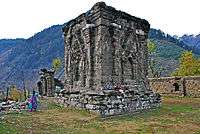Lava Temple
Lava Temple (Urdu: لو مندر) is a Hindu place of worship dedicated to the Hindu deity Lava, the son of Rama. It is in Lahore Fort, Lahore, Pakistan, and dates to the Sikh period.[1] According to a Hindu legend,[2] Lahore is named after him.[3]
| Lava Temple of Lahore | |
|---|---|
A view of the temple’s dome from the walls of the Lahore Fort | |
| Religion | |
| Affiliation | Hinduism |
| Deity | Lava (Ramayana) |
| Governing body | Pakistan Hindu Council |
| Location | |
| Location | Lahore, Punjab
Pakistan |
 Shown within Pakistan | |
| Geographic coordinates | 31°35′18″N 74°18′46.4″E |
| Architecture | |
| Type | Hindu temple |
| Temple(s) | 1 |
| Website | |
| http://www.pakistanhinducouncil.org/ | |
Etymology
In the Deshwa Bhaga, Lahore is called 'Lavpor', which points to its origin from Lav, the son of Rama,. In the ancient annals of Rajputana the name given is 'Loh Kot', meaning “the fort of Loh” which, again, has reference to its founder,Rama's son.[4]
History
A legend based on oral traditions holds that 'Lahore', known in ancient times as 'Lavapuri' (City of Lava in Sanskrit),[5] was founded by Prince Lava,[6] the son of Sita and Rama. Kasur was founded by his twin brother Prince Kusha.[7]

To this day, Lahore Fort has a vacant temple dedicated to Lava (also pronounced Loh, hence Loh-awar or "The Fort of Loh").[8]
The oldest authentic document about Lahore was written anonymously in 982. It is called Hudud-i-Alam (The Regions of the World).[9] In 1927 it was translated into English by Vladimir Fedorovich Minorsky and published in Lahore. In this document, Lahore is referred to as a small shehr (city) with "impressive temples, large markets and huge orchards." It refers to "two major markets around which dwellings exist," and it mentions "the mud walls that enclose these two dwellings to make it one." The original document is currently held in the British Museum.[10]
Lahore was called by different names throughout history. To date there is no conclusive evidence as to when it was founded. Some historians trace the history of the city as far back as 4000 years ago.[11] However, historically, it has been proved that Lahore is at least 2,000 years old. Lying on the main trade and invasion routes to South Asia, Lahore has been ruled and plundered by a number of dynasties and hordes.
See also
- Hinduism in Pakistan
- Evacuee Trust Property Board
- Pakistan Hindu Council
- Krishna Mandir, Lahore
- Valmiki Mandir, Lahore
- Temples in Lahore
- Hinglaj Mata
- Katasraj temple
- Multan Sun Temple
- Prahladpuri Temple, Multan
- Sadh Belo
- Shivaharkaray
- Shiv Mandir, Umerkot
- Shri Varun Dev Mandir
- Tilla Jogian
References
- Zamir, Sufia (2018-01-14). "HERITAGE: THE LONELY LITTLE TEMPLE". DAWN.COM. Retrieved 2020-04-27.
- Khalid, Haroon (2018-12-31). "How old is Lahore? The clues lie in a blend of historical fact and expedient legend". DAWN.COM. Retrieved 2020-01-11.
- Annual Bibliography of Indian History and Indology. 1946.
- History of Lahore
- Bombay Historical Society (1946). Annual bibliography of Indian history and Indology, Volume 4. p. 257. Retrieved 2009-05-29.
- Baqir, Muhammad (1985). Lahore, past and present. B.R. Pub. Corp. pp. 19–20. Retrieved 2009-05-29.
- Nadiem, Ihsan N (2005). Punjab: land, history, people. Al-Faisal Nashran. p. 111. Retrieved 2009-05-29.
- Naqoosh, Lahore Number 1976
- HUDUD AL-'ALAM 'The Regions of the World' A Persian Geography Archived 2006-10-24 at the Wayback Machine
- Dawn Pakistan - The 'shroud' over Lahore's antiquity
- "Glasgow gets a new twin in Lahore". Living in Glasgow. 14 September 2006. Archived from the original on 28 February 2009. Retrieved 2009-07-06.

